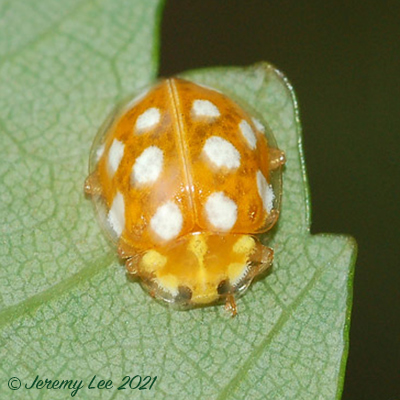
 |
|
Scientific Classifications explained » Amphibians » Ants » Aphids » Bees » Beetles » Birds » Bugs » Butterflies » Caterpillars » Damselflies » Dragonflies » Earwigs » Flies » Frog/Leafhoppers » Fungi » Galls » Grasshoppers » Harvestmen » Hoverflies » Lacewings » Ladybirds » Leaf Mines » Lichens » Mammals » Millipedes » Mosses » Moths » Sawflies » Slugs » Snails » Spiders » Trees & Shrubs » Wasps » Wild Flowers » Woodlice » Postboxes |
UK Nature > Ladybirds > Halyzia sedecimguttata

Scientific Name: Halyzia sedecimguttata Common Name: Orange 16-spot Ladybird Halyzia sedecimguttata, more commonly known as the Orange 16-spot Ladybird, measures approximately 5-6mm in length, It is bright yellow or orange in colour, with a translucent border to the wing casings and pronotum (the bit between the head and wing casings). It usually has 16 creamy-white coloured spots, but there can be as few as 14. Head and legs are orange, and the eyes are black. The Orange 16-Spot is mycetophagous (fungus eating) and lives on the mildews of various broad-leaved trees, such as Sycamore. Formerly uncommon, it has established itself over the latter part of the 20th century and is now much more readily encountered. It is an unusual ladybird, as it may overwinter as a pupae, unlike most of the other species in the UK. It can be confused with no other species except possibly immature Cream-spot ladybirds. |
|

https://www.uknature.co.uk is a website dedicated to showing the immense diversity of UK nature and wildlife. Our vast range of habitats, from lowland arable to snow covered mountains, from storm-ravaged coastlines to peaceful inland freshwater lakes and rivers, from dry, sandy heaths to deciduous and coniferous forests, all these habitats contribute to the abundance of UK nature. We have wild birds in huge numbers either residing or visiting our shores (597 recorded species as at July 2013) and we must also not forget the humble back garden with its grass lawns, flower beds filled with nectar rich flowers, shrubs and trees, all designed to attract huge numbers of insects such as bees, moths, butterflies and hoverflies; and finally the small ponds which provide safe havens for frogs, toads, newts and even slow worms and grass snakes. www.uknature.co.uk is the showcase for my personal passion, photographing uknature in all its glory. I sincerely hope you all enjoy the fruits of my labours. This site and all images contained therein is © Jeremy Lee 2004 - 2025. All Rights Reserved. Site design by Jeremy Lee. Site development & IT Support by Stuart Lee. |